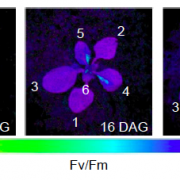RNA helicases and hybrid breakdown in A. thaliana
Chlorosis caused by two recessively interacting genes reveals a role of RNA helicase in hybrid breakdown in Arabidopsis thaliana
Björn Plötner, Markus Nurmi, Axel Fischer, Mutsumi Watanabe, Korbinian Schneeberger, Svante Holm, Neha Vaid, Mark Aurel Schöttler, Dirk Walther, Rainer Hoefgen, Detlef Weigel, Roosa A. E. Laitinen
Plant J. 2017 Apr 4. doi: 10.1111/tpj.13560
Hybrids often differ in fitness from their parents. They may be superior, translating into hybrid vigour or heterosis, but they may also be markedly inferior, because of hybrid weakness or incompatibility. The underlying genetic causes for the latter can often be traced back to genes that evolve rapidly because of sexual or host-pathogen conflicts. Hybrid weakness may manifest itself only in later generations, in a phenomenon called hybrid breakdown. We have characterized a case of hybrid breakdown among two Arabidopsis thaliana accessions, Shahdara (Sha, Tajikistan) and Lövvik-5 (Lov-5, Northern Sweden). In addition to chlorosis, a fraction of the F2 plants have defects in leaf and embryo development and reduced photosynthetic efficiency. Hybrid chlorosis is due to two major-effect loci, of which one, originating from Lov-5, appears to encode an RNA helicase (AtRH18). To examine the role of the chlorosis allele in the Lövvik area, in addition to eight accessions collected in year 2009, we collected another 240 accessions from 15 collections sites, including Lövvik, from Northern Sweden in year 2015. Genotyping revealed that Lövvik collection site is separated from the rest. Crosses between 109 accessions from this area and Sha revealed 85 cases of hybrid chlorosis, indicating that the chlorosis causing allele is common in this area. These results suggest that hybrid breakdown alleles not only occur at rapidly evolving loci, but also at genes that code for conserved processes.




